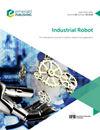基于激光跟踪仪的六自由度串联工业机器人关节传动比顺序标定
IF 2.5
4区 计算机科学
Q3 ENGINEERING, INDUSTRIAL
Industrial Robot-The International Journal of Robotics Research and Application
Pub Date : 2023-09-12
DOI:10.1108/ir-05-2023-0115
引用次数: 0
摘要
目的在传统的工业机器人运动学参数标定方法中,基于优化过程对数十个模型参数进行综合辨识。由于模型参数误差对工业机器人刀具中心点定位误差的贡献不同,对所有模型参数都要得到较好的结果是非常困难的。因此,本文的目的是提出一种针对传动比参数的顺序校准方法,其中包括工业机器人关节的减速比和耦合比。设计/方法/方法本研究以ABB IRB 1410工业机器人为例。采用基于空间矢量的空间圆拟合方法确定机器人各关节的传动比,并用最小二乘优化算法拟合关节旋转的中心和半径。此外,设计并提出了一种基于Rodrigues公式的机器人实际耦合比辨识方法。随后,通过实验验证了所提出的传动比顺序标定方法。在本实验中,用激光跟踪仪测量了关节旋转前后连杆的实际位置。计算了减速比和耦合比的精确结果,并进行了实验验证。结果表明,通过标定ABB机器人的减速比和耦合比,可以减小机器人关节的转角误差。提出了一种工业机器人关节传动比参数的顺序标定方法,包括减速比和耦合比。通过实验验证了该方法的正确性。该研究对工业机器人运动学参数的标定和定位精度的提高具有一定的指导意义。本文章由计算机程序翻译,如有差异,请以英文原文为准。
Sequential calibration of transmission ratios for joints of 6-DOF serial industrial robots based on laser tracker
Purpose
In traditional calibration methods of kinematics parameters of industrial robots, dozens of model parameters are identified together based on an optimization procedure. Due to different contributions of model parameter errors to the tool center point positioning error of industrial robots, obtaining good results for all model parameters is very difficult. Therefore, the purpose of this paper is to propose a sequential calibration method specifically for transmission ratio parameters, which includes reduction ratios and coupling ratios of industrial robot joints.
Design/methodology/approach
The ABB IRB 1410 industrial robot is considered as an example in this study. The transmission ratios for each joint of the robot are identified using the spatial circle fitting method based on spatial vectors, which fit the center and radius of joint rotation with the least squares optimization algorithm. In addition, a method based on the Rodrigues’ formula is designed and presented for identifying the actual coupling ratio of the robot. Subsequently, an experiment is carried out to verify the proposed sequential calibration method of transmission ratios.
Findings
In this experiment, the actual positions of the linkages before and after joint rotations are measured by a laser tracker. Accurate results of the reduction ratios and the coupling ratios are calculated, and the results are verified experimentally. The results show that by calibrating the reduction ratios and coupling ratios of the ABB robot, the rotation angle errors of the robot joints can be reduced.
Originality/value
The authors propose a sequential calibration method for transmission ratio parameters, including reduction ratios and coupling ratios of industrial robot joints. An experiment is carried out to verify this proposed sequential calibration method. This study may be beneficial for calibrating the kinematic parameters of industrial robots and improving their positioning accuracy.
求助全文
通过发布文献求助,成功后即可免费获取论文全文。
去求助
来源期刊
CiteScore
4.50
自引率
16.70%
发文量
86
审稿时长
5.7 months
期刊介绍:
Industrial Robot publishes peer reviewed research articles, technology reviews and specially commissioned case studies. Each issue includes high quality content covering all aspects of robotic technology, and reflecting the most interesting and strategically important research and development activities from around the world.
The journal’s policy of not publishing work that has only been tested in simulation means that only the very best and most practical research articles are included. This ensures that the material that is published has real relevance and value for commercial manufacturing and research organizations. Industrial Robot''s coverage includes, but is not restricted to:
Automatic assembly
Flexible manufacturing
Programming optimisation
Simulation and offline programming
Service robots
Autonomous robots
Swarm intelligence
Humanoid robots
Prosthetics and exoskeletons
Machine intelligence
Military robots
Underwater and aerial robots
Cooperative robots
Flexible grippers and tactile sensing
Robot vision
Teleoperation
Mobile robots
Search and rescue robots
Robot welding
Collision avoidance
Robotic machining
Surgical robots
Call for Papers 2020
AI for Autonomous Unmanned Systems
Agricultural Robot
Brain-Computer Interfaces for Human-Robot Interaction
Cooperative Robots
Robots for Environmental Monitoring
Rehabilitation Robots
Wearable Robotics/Exoskeletons.

 求助内容:
求助内容: 应助结果提醒方式:
应助结果提醒方式:


